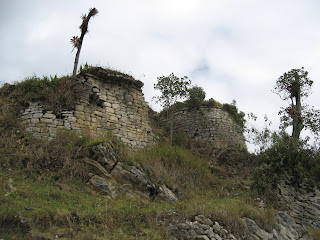 Frank, Jeny's father and crew looking for ruins
Frank, Jeny's father and crew looking for ruinsTuesday, June 30, 2009
Misc photos from Peru May-June 2009
Mountains near Huarez Peru & Frank, Jeny's father and crew looking for ruins
Frank, Jeny's father and crew looking for ruins
 Frank, Jeny's father and crew looking for ruins
Frank, Jeny's father and crew looking for ruins“The Sanctuary”


These ruins are in a different province (Luya), not all that far from where the famous mummies were found that year we were in the area. The Sanctuary is on the vast property of my brother-in-law’s father. I think it has religious significance because of the pyramid symbols or upside-down “V”s. These same symbols are all over the first Christian church built by the Chachapoyans. This church, which can still be seen today in La Jalca Grande, is a mixture of Chachapoyan and Spanish/Christian influences. Note: There are other high quality ruins nearby, that appear to be known only by the landowner’s family and friends.
WIMBA RUINS






THE WIMBA RUINS:
These ruins are located in the province of Rodriguez de Mendoza, state/district of Amazonas, not far from the San Martin border (alt 5260 ft). There is a tiny village nearby (Tocuyo), which is known for coffee and coffee liquor. A good, or crazy, driver can get you within 20-30 mins climbing of the ruins. Mendoza is the local capitol and reminds me of an old wild-west type of town. During the 2 hour trip from Mendoza to Tocuyo you will pass some well known and well looted cliff and cave tombs (La Ventana of Omia).
The Wimba Ruins are owned by a local farmer and look like a very mini-Kuelap. They are part of a series of sites that are locally known, but very few people know of them outside of Rod d. Mendoza and I may be the only foreigner who has seen them. The site has many exotic and medicinal plants growing in the area (e.g., Sangre de Grado), as well as cultivated cash crops (mainly coffee); the ruins themselves are named after the Wimba tree. About half of the fortress walls have been partially destroyed by vegetation, but the rest are in amazing shape (PHOTO 1). Within the walls are several standard, east-facing, Chachapoyan circular ruins, some fair shape some not (PHOTO 2). The owner said there were more ruins below the walls and some graves (I saw one – nothing left now except a piece of painted pottery and a bone). The site has a lot of bola stones, stone bowls, grinding stones, pottery shards, and fossils (PHOTOS 3-5). There was also part of a stone tablet with an unknown inscription – presumably the other part is up there somewhere.
Also of note in the region is a very large cave – several stories high with different chambers and a lot of scenic rivers and waterfalls.
These ruins are located in the province of Rodriguez de Mendoza, state/district of Amazonas, not far from the San Martin border (alt 5260 ft). There is a tiny village nearby (Tocuyo), which is known for coffee and coffee liquor. A good, or crazy, driver can get you within 20-30 mins climbing of the ruins. Mendoza is the local capitol and reminds me of an old wild-west type of town. During the 2 hour trip from Mendoza to Tocuyo you will pass some well known and well looted cliff and cave tombs (La Ventana of Omia).
The Wimba Ruins are owned by a local farmer and look like a very mini-Kuelap. They are part of a series of sites that are locally known, but very few people know of them outside of Rod d. Mendoza and I may be the only foreigner who has seen them. The site has many exotic and medicinal plants growing in the area (e.g., Sangre de Grado), as well as cultivated cash crops (mainly coffee); the ruins themselves are named after the Wimba tree. About half of the fortress walls have been partially destroyed by vegetation, but the rest are in amazing shape (PHOTO 1). Within the walls are several standard, east-facing, Chachapoyan circular ruins, some fair shape some not (PHOTO 2). The owner said there were more ruins below the walls and some graves (I saw one – nothing left now except a piece of painted pottery and a bone). The site has a lot of bola stones, stone bowls, grinding stones, pottery shards, and fossils (PHOTOS 3-5). There was also part of a stone tablet with an unknown inscription – presumably the other part is up there somewhere.
Also of note in the region is a very large cave – several stories high with different chambers and a lot of scenic rivers and waterfalls.
Subscribe to:
Comments (Atom)





























